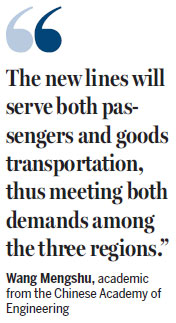New railways get integration underway
Construction of a high-speed railway connecting Beijing and nearby Tangshan, Hebei province, will start within the year, said Liu Bozheng, deputy director of the Beijing Development and Reform Commission, during a recent forum on Beijing-Tianjin-Hebei integration.
The railway is considered a key line of the "one-hour-trip zone" in and near Beijing. To support the integration process, authorities hope to build ample infrastructure to make it possible to travel in the region within one hour.
According to Wang Mengshu, an academic from the Chinese Academy of Engineering and an experienced railway engineer, several high-speed railways connect Beijing and Tianjin but none serve Hebei; the Beijing-Tangshan line will be the first.
As well as the Beijing-Tangshan line, the second environmental impact evaluation has started on another inter-city railway listed in the plan, the Beijing-Zhangjiakou line. If passed, construction could start on one part of it, at the Badaling Mountain area, within months.
In a guiding document on transportation facility development issued by the National Commission of Development and Reform on May 27, authorities vowed to build "a region on rails" and raised the plan of more intercity railways. Surveys are being done on the lines that link Beijing and Chengde and Hengshui, in Hebei province, and more train lines are expected.
"The first high-speed railway linking Beijing and Tianjin was designed for passengers only and hardly helps cargo transportation," said Wang.
"The new lines will serve both passengers and goods transportation, thus meeting both demands among the three regions."
A research report by China International Capital Corp Ltd shows that passenger and goods transportation facilities in the Beijing-Tianjin-Hebei region are far from enough to meet the demand. The CICC report compares the region with the Yangtze River Delta and Pearl River Delta, two traditionally prosperous regions in China with relatively better infrastructure, and found there is still a gap.
Another railway expert advocated that goods transportation in the region should be mainly done through railways.
For general goods, transport by rail costs a third or even half the cost of road transport. For iron ore or coal it is a tenth of the cost by road transport. With new intercity railway lines linking Beijing and neighboring cities being opened, residents in the whole region are expected to enjoy lower living costs.
Railway is only one of the transportation means of the "one-hour-trip zone", more highways will be lengthened to link cities with each other as well, said Liu Bozheng.
Some roads built in the 1990s are too narrow to meet the growing demand for vehicle flow and, under the plans, they will be widened to make travel better for both passengers and goods, he added.
zhuanti@chinadaily.com.cn

|
Passengers prepare to board a high-speed train to Tianjin at Beijing South Railway Station. Travel time has been shortened to about 40 minutes because of the high-speed railway. Wang Yueling / for China Daily |
(China Daily 06/19/2015 page10)















